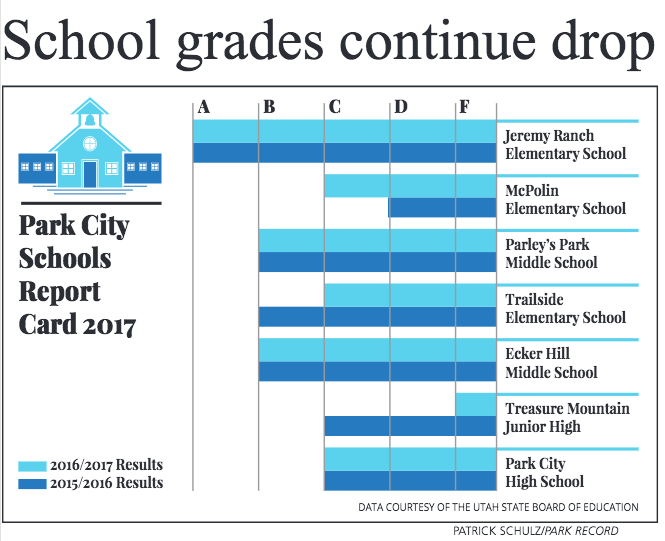Is Park City hard to get to?
One of the things I’ve always heard is that Park City is so easy to get to, that we will always be flooded with tourists. It makes sense, with us being around 30 minutes from the airport. You compare any Colorado destination, and the distance from Denver is usually in the 1-2 hour (or longer) range.
This morning I was reviewing a presentation from the Chamber and it had a study results slide. The study took into account 1800 persons from 8 markets. Naturally it found that Park City was way above average on being family-friendly, providing a variety of activities, etc. However, we barely ranked as average (not in the top 25%) in “easy to get to.”
I’m not sure if survey responders just don’t know where Park City is, perhaps they have had some bad winter driving in Parley’s Canyon, or maybe they are just pissed that the Uber-Copter no longer flies, but was a little surprising.
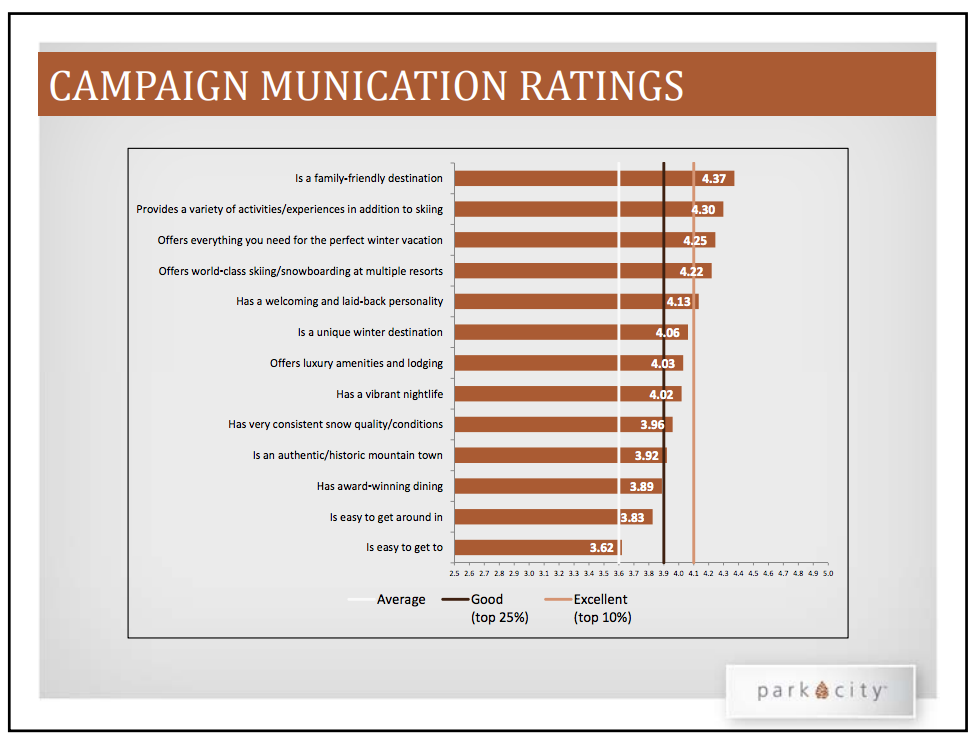
Interested in the Chamber of Commerce’s Summer results and Winter marketing? Here’s a preview.
Today the Park City Chamber of Commerce is presenting to the Summit County Council on its Summer results and Winter plans. Since the Chamber is substantially funded through Transient Room tax dollars allocated by the County Council, and there were discussions earlier this year about revisiting that allocation, this meeting is an important one. Here are a few of the slides that will be likely be presented:

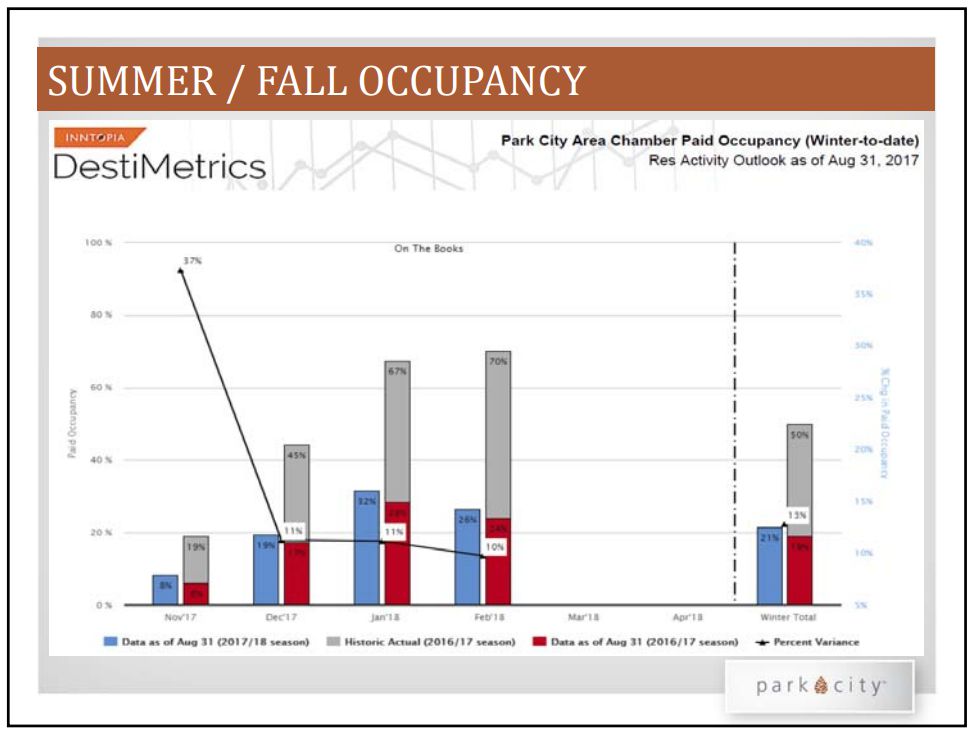
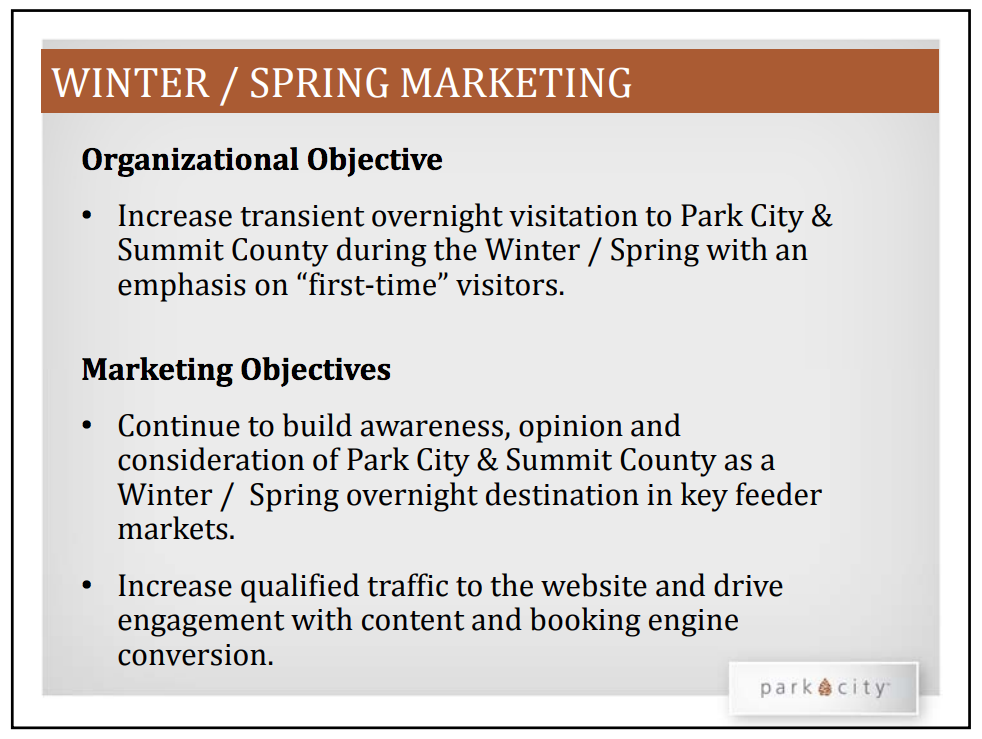
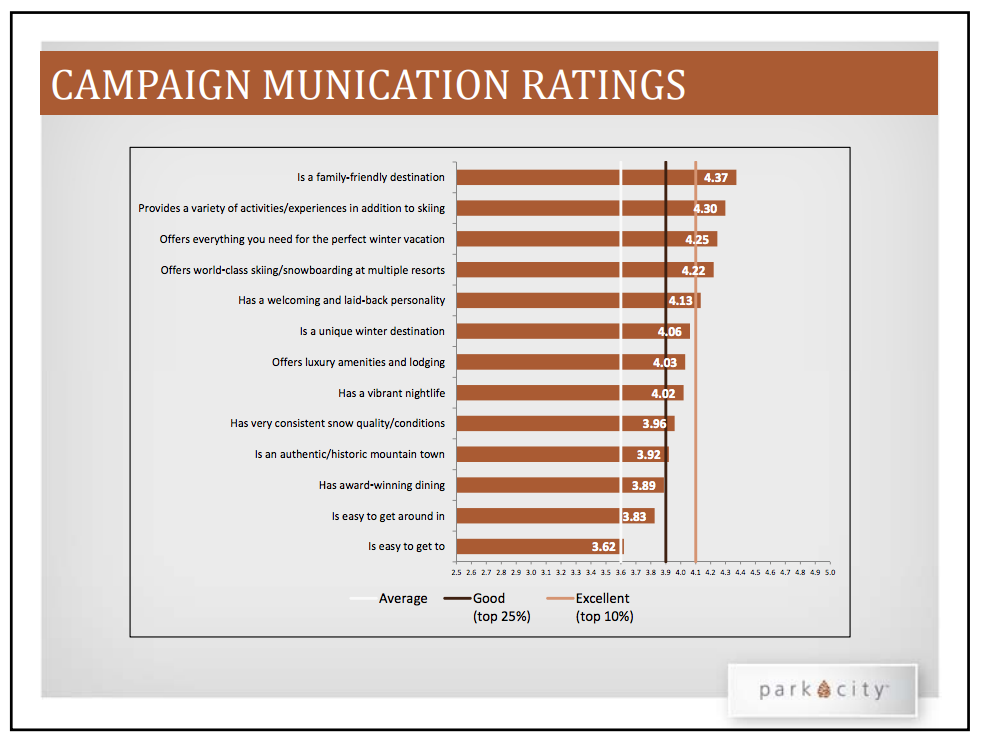
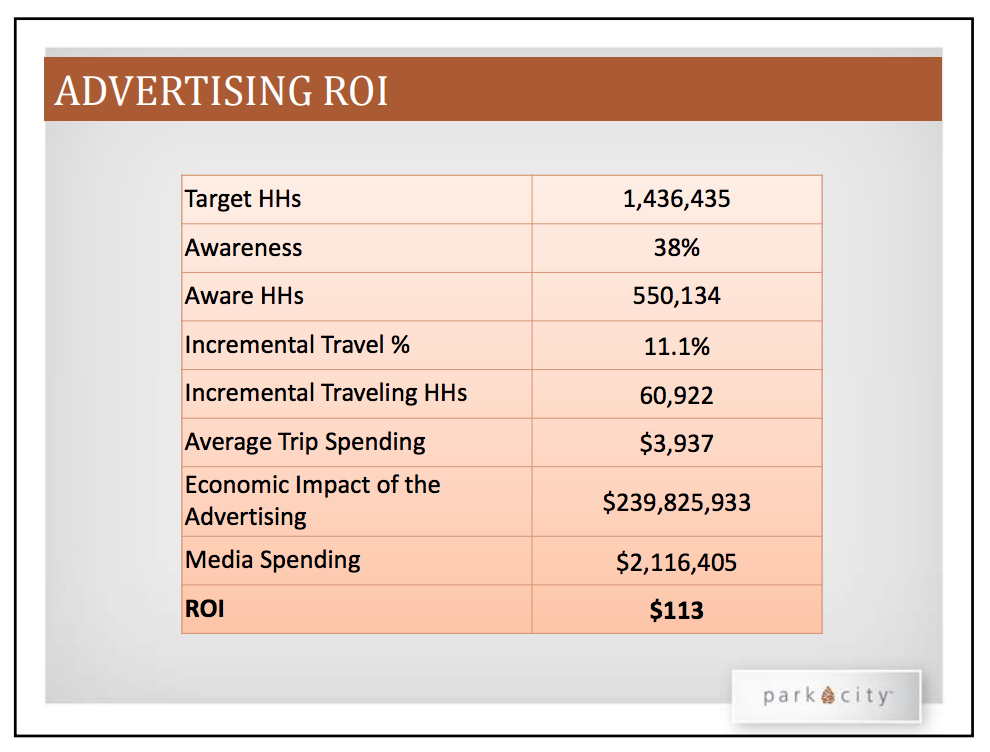
Again, if you’d like to see the whole presentation, you can click here.
We’re not made of money
The spat between the County Council and Summit Land conservancy over the purchase of the Osguthorpe Farm highlights a problem. Our governments aren’t made of money. Summit County offered to pony up $4 million to help Summit Land Conservancy buy the land, but the land conservancy needs $5.5 million to complete the purchase. The land conservancy rejected the county’s offer due to a number of conditions that the county apparently made with offer. The fact that the county says they can offer $4 million is surprising in itself.
The problem is that we spend millions on Bonanza Flat. We spend millions on the Cline Dahl’s parcel. We may spend millions on the Osguthorpe Farm. Yet, we have to raise property taxes because we can’t cover expenses (like roads). We get that each of those projects (Bonanza Flat, etc) have their merits… but not when you are broke. It’s like having no money, buying a Tesla, and justifying it because it’s emission free.
Some day, not too far away, these chicken are going to come home to roost.
How desperate are we for affordable housing?
There are a few things in the Park City area that nearly every local agrees upon. One of those is the need for affordable housing. Unfortunately during the last few years, not much affordable housing has come online. It appears that Summit County is trying to accelerate that process. The question is, at what cost?
Last week, the Summit County Council met in joint session with the Snyderville Basin Planning Commission to discuss affordable housing at Silver Creek Village. Silver Creek Village is the new development by the Home Depot. Once completed it will be one of the most populous neighborhoods in the Park City area. There are also a sizable number of affordable units as part of the project.
According to Mountainlands Community Housing Trust Executive Director, Scott Loomis, this is the type of affordable housing the community needs. It will a mix of rental and purchase units. A portion of the affordable units will be target to those making 25% of area medium income (AMI). That would be about a $25,000 annual salary.
There aren’t many of these types of units available in the Snyderville Basin currently. In fact, we often shake our heads when we hear the terms affordable or attainable housing. That’s because sometimes they are $400,000 or $500,000. That’s not exactly cheap or something attainable by a person making just over minimum wage.
330 units are slated to be completed as part of the project. It’s been estimated that the area needs about 1,000 affordable units over the next five years. Silver Creek’s number, combined with the approximate 500 units (1000 beds) at the base of the Canyons, the 78 units at Park City Heights, and the 52 upcoming units as part of the Discovery project, means we would be close to meeting affordable housing needs.
Therefore, there’s a lot to be excited about with this project and the potential for affordable housing around Park city and the Snyderville Basin. So, what’s the issue?
It’s a matter of planning.
The Snyderville Basin General Plan, and the development agreement that represents Silver Creek Village, states that the affordable units must be integrated into the development. The idea of true integration is that for every four or five townhouses, condos, etc. there will be one affordable unit interspersed with the more expensive units. The idea is that you don’t put all affordable units in one area, because it’s not optimal for community integration. Economic segregation has shown to have negative mental and other health effects. It’s also shown to have negative impacts on children.
It really just makes sense. For one of the largest developments in the Park City area, do we want million dollar homes in one area and all the affordable housing put into another area? It seems reminiscent of the projects in 1970’s Chicago. No, it seems the optimal outcome would be to have affordable units mixed in with market rate units. This allows for economic diversity and probably cultural diversity, too.
Yet, the desire by the Summit County Council and Mountainlands Community Housing to push forward with little-to-no integration of units is glaring.
County Council Member Roger Armstrong says, “We can wait and design what may be perfectly integrated, and people feel like a part of the community, but we will still be further and further behind [with affordable housing].”
The other problem with non-integration, of course, is that it violates the Snyderville Basin General Plan — the document that guides development in the basin. The General Plan calls for affordable housing to be integrated into the development. Snyderville Basin Planning Commissioners cited the upcoming Discovery development (above Weilenman School) as a design that had become fairly integrated. So, it is possible top achieve.
Much of the talk during this meeting turned to whether the Planning Commission could find a way to define the development’s affordable housing as integrated. It looks like Mountainlands had already conceded that their original plan was not integrated, so they came up with a revised plan. The revised plans spreads out the affordable housing a bit, but it’s probably not truly integrated.
Planning Commissioner Chair Canice Harte commented that the design did look more integrated but that this was a the first time the commission had seen it. The Planning Comission is going to meet again in the upcoming weeks and discuss integration.
The problem, as we see it, is that community integration is a little like pornography — you’ll know it when you see it. When we look at the revised plan by Mountainlands we suppose it does look a little more integrated than the original plan. However, that is only because we are comparing it to a completely non-integrated design. On its own merits, we don’t think the community will be truly integrated with the new design. Of course the Planning Commission could see it differently.
The other problem we see is that even having the meeting is a sign of throwing out the rules. This meeting was held, the best we could tell, so that the Planning Commission could be convinved that they should not worry about integration…. and then if they did… to tell the County Council… so the County Council could amend the development agreement so that it didn’t have to be integrated. Mountainlands Director Scott Loomis said he even had the amendment ready to go, and intimated that it may have already been agreed upon. If that’s true, and it’s now standard operating procedure, every applicant for development who runs into issues should be able to have a joint meeting with the County Council and Planning Commission to work out differences. The fact that this meeting even happened seems outside the norm.
We’re not blind to reality, though. We understand why many of the council members want to move forward quickly. They are pushed by the public and have run on platforms of addressing affordable housing. It’s also true that there is a dearth of affordable housing and not much has been actually accomplished on that front. It has to be frustrating.
The argument for ignoring integration is that you can front-load building of affordable housing. You can build a large amount of affordable housing in a few areas at the beginning of the project. It can get affordable housing up quickly. Conversely, if you want a truly integrated design, these affordable units would be built over the next 15 years, as the development is built. So, it would take a while to build them and the area wouldn’t get an immediate affordable housing infusion. It’s also likely that some of the affordable housing would be done by the developers of the market-rate units. This would likely mean they would charge as much as they could for each unit and not make units available to people making $25,000 a year. So, there are advantages to damning the torpedoes and going full speed ahead.
That said, one of the first things we learned about development in Park City sticks out. You have to make good decisions before you build something because you can’t unbuild it. The decisions made on this will last forever and since this development is so large, we as a community have to get it right.
It’s also important to point out that not everyone on the County Council thinks this is a good development for affordable housing. Long-time developer and County Council member Doug Clyde said during the meeting, “This thing is a village in only name. I’ve been Developing for 30 years and I’ve never had a project not called a village. This is not a village. There is no walkable community here. There are no restaurants. There are no stores here. It will never be that sort of density. This is a bad place for apartments… because they are going to have two types of [driving] trips… one to work, one from work, one to the store, one from the store, one to the school, one from the school. Putting apartments up here is putting five times as many trips on the road as if they [workers] come from Salt Lake. It’s a bad place for them. It’s a bad location… Frankly, I’d rather see less workforce housing. I’d rather see fewer units because I don’t think this area will ever be positively serviced by transit.”
Mr Clyde knows his business and in the long-term there is a good chance he’ll be proven right. However, we are confident that one way or another there are going to be over 300 units of affordable housing at Silver Creek. It’s just a matter of how it is done and when.
We think we owe it to the long-term vision of the Park City area to do this one right. In some ways, this one already seems a little tainted. However, we do still have the opportunity to make sure we are doing this in the right way — adhering to the values that have been set forth in the General Plan.
If we don’t, it will likely be another of those developments that looks very foolish in hindsight. It will be one of the developments someone looks at in 15 years and says, “how did they ever let that happen?”. We may get 300 units of affordable housing in 2019 but at what long-term cost.
The Kids are Alright: Why we never want to hear about the SAGE test again
The Park Record headline screams:
We especially like the chart’s title: “Park City Schools Report Card 2017”. This must be official!
Wow, did a virus invade and destroy the childrens’ brains at Treasure Mountain. It must have because the same kids who were getting B’s at Ecker Hill and C’s at Treasure Mountain last year are now getting F’s. There must have also been huge teacher turnover in order for the education to have fallen so far so fast. There must be a fundamental issue with education in Park City that we need to solve today!
Or it’s all just bullsh*t.
We’ll take the latter.
SAGE is a standardized test given to Utah students since 2013. The Utah State Board of Education mandates that schools provide this test to students annually. The results of the test can be used by teachers and administrators to help individual students and to judge academic growth. The results are then used to label a school with a grade (A-F). For Park City High, SAGE forms part of the grade. For all other schools in our district, SAGE results determine the entire grade.
So, slapping Treasure Mountain with an F simply means it’s SAGE tests weren’t great. That must mean something right? Let’s look at the scores of the best high school in Utah according to US News and World Report. That would be Karl G Maeser Preparatory Academy. What are their SAGE scores:
- 51% of students are proficient are language arts
- 59% percent are proficient in math
- 53% percent in science
What about the number two high school in Utah, Park City High? 51% proficient in language arts, 51% in math, and 53% in science.
If either of these scores were indicative of a “Report Card,” as the Park Record calls it, then the entire staff and administration of both Karl Maeser and Park City should probably be let go. The better question is do you think our students are a bunch of dumb-ass*s? Probably not. Do you think our teachers are a bunch of know-nothings that can’t educate anyone out of a bag? Probably not.
So, why are test scores so low?
Former Alpine School District Board of Education member Brian Halladay would likely tell you that the company that designs the SAGE test isn’t qualified. In a 2015 email to parents, Halladay says that the SAGE test was designed and created by AIR, “one of the world’s largest social and behavioral research companies” and not by teachers or educators. He recommended that parents opt out of the test.
That leads to the second problem with judging schools based on SAGE scores… kids opt out. In Park City 21% of kids opt out. Do we know if the best-test-taking-kids are the ones opting out? No, but it makes sense.
The third-reason why test scores may be low is that some students don’t take it seriously. According to the Park Record article, Park City District Spokeperson Mindy Colton says that kids are “sabotaging” the test scores by finishing too quickly or drawing on the back of tests. This isn’t new, though. A report we read talks about students in 2004 in New Mexico that like to make Christmas Trees and Battleships out of the answer bubbles. If kids don’t find the value in it, they aren’t going to waste time or effort.
So what is the SAGE test good for? Absolutely nothing. It’s good for a student who wants to use it, in cooperation with their teachers and parents, to improve parts of their education (the PCSD also uses the Galileo tests for this purpose). It’s not a referendum on our teachers. It’s not a a final grade for our schools. It’s not an indication of educational success of our district.
In our opinion, the worst thing parents could do is go to the Park City School District and demand that we are #1 in SAGE tests. Please do not email TMJH Principal Emily Sutherland and demand action. The outcome of that will be that the school district will be pressured to improve SAGE results. How do you do that? You teach to the standardized test.
Is that what we want?
This isn’t to say that Park City’s education is perfect. It’s true that our kids are going to be competing against kids from states that spend more on education. It’s true that students in Korea spend day and night at school in order succeed later in life. It’s true that almost every school district wants to achieve the results of Finland. It’s true that Park City still has an achievement gap related to English language learners.
However, the grades assigned to schools based on SAGE scores isn’t going to make any difference with any of that.
To be fair, we at the Park Rag have brought up SAGE scores in the past. We’d like to think we have a better perspective now. You’ll likely never read another article on the Park Rag correlating SAGE scores with our children’s education.
We also hope we never have to read another article in the Park Record that cites the results of SAGE testing. We hope we never have to read the school district getting defensive about the scores of a standardized test. It’s meaningless in the aggregate. We believe it has little to no influence on the whether a child gets a good education in Park City.
We hope instead our parents, schools, and media will continue to focus on providing a quality education to all students. That, and not SAGE, is what has the greatest potential to provide a superior educational experience to our kids.
Is Park City’s E-Bike system successful? The numbers don’t indicate that… but we hope it eventually will be.
We received a tip from a reader pointing us to a Park Record article about both the success and troubles with the Park City/Summit County E-Bike program (Thanks to the person who sent it in).
We’re honestly conflicted about the E-Bike program. We want to see it succeed because we ultimately believe e-bikes blend transportation with the best parts of Park City. Yet, we can’t let go of the issues they have had. Every week we hear from someone who have had serious problems with the program. Yet, the company that is managing the program uses veterans of foreign wars to help support it. How can you be too critical of people who have served our country and likely saw things that you or I would never want to experience?
It’s complicated.
So we come back to numbers. The Summit County Officials said that there have been 7,000 rentals of bikes and that success “shocked” them (in a good way). The Park Record article stated there were 80 bikes being rented. We know that the program has been operating for 49 days (since the end of July). That means that each bike was used 1.77 times per day.
So, it’s likely that each bike used for about a hour or two a day. That’s great! Or is it?
Wikipedia tells us that a well functioning bike share is used 10-15 times per day per bike. However, our system is new and just getting started — so perhaps we should expect less (for now)? Other sources, seem to state that between 6-10 uses per bike per day is normal. The question becomes how much traffic is taken off the road. If each bike is used 1.8 times per day, and 75% of that usage takes a car off the road. That means 108 cars are taken off the road each day (at least during summer). Is that worth the money? It may or may not be depending on when the usage happens.
We’ve also heard that people are driving up from the valley to try it out. We’re not sure if that is actually taking cars off the road, which was the reason we spent a million dollars (including grants) on the project. We’ve also been to many concerts where people are just “trying it out” as they ride around New Park.
That gets us back to the meat of the argument. The E-Bike share was designed to get cars off the road. It is a traffic mitigation concept. The Park Record article did not address that at all. If the city and county are providing an electric cruiser bike “for fun” at $2 an hour… that’s sounds like entertainment. So, how many cars have been taken off the road? Are visitors not renting a car? Are people from SLC parking at the library in KJ and taking a bike? Are residents using a bike and forgoing a car to do their daily tasks (or recreation)? Ultimately, that is the test of success.
So, it sounds like we need about 3-5 times more riders to meet the average “biker-ship” seen with a bike share. Stated positively… We have goals that we can aspire to.
We’re nearing the end of the summer. According to initial estimates the E-bike share will run into November. We’ll believe that when we see it (you won’t see me on my Pedego in November very often). How is that battery going to last when the snow falls and temperature drops? How will those thin tires tackle snow?
We see the future in the quote from the Park Record article…County Manager Tom Fischer said, “Our biggest thing is before we get into buying more bikes, which the early days shows the demand is there, we want to make sure we evaluate the whole thing. And we may have to look for a different provider. But, it’s clear from the early experience that people want it and they can use a system like this in our community.”
What we hope to see is that people adopt E-Bikes as an alternative form of transit. We hope that cars are taken off the road. We hope that it is seen as more than a novelty.
The numbers tell us that the city and county need to increase the usage by about five fold and then also show that those users are forgoing car tips… in order to show that the program is truly meeting the goal of reducing traffic.
We look forward to seeing what happens in Spring 2018.
Why Park City School District trust is so important
There is an interesting debate going on in our comments about the public’s ability to direct the school district in its needs for expansion.
Some say that the public will always find fault with something in every plan. Therefore, that’s why we elect a school board to make decisions. If you don’t like the board’s decisions, then vote new people in.
Other people say that public is crucial to the process to ensure that a proper outcome occurs.
We think this highlights the need for trust in the process.
Take for example adding a 5/6 school at Ecker Hill (that has been proposed by the district). You may not like the traffic impacts. You may not like the added transitions between schools (which has proven to hurt education). You may not like 5th graders at the same school at 8th graders.
However, if you trust the school district and their process, you’ll probably come to the conclusion that while there are a number of issues, putting a 5/6 school at Ecker is probably the best out of a number of imperfect choices.
However, if you don’t trust them, you nitpick the issues and conclude that they don’t have a clue.
Without trust in the district, that nitpicking will likely make any bond effort the district puts forward hard to pass.
We think the school board and district are making strides toward gaining trust. Whether they can move the needle enough in the next year or two will likely determine the course of the district for the next decade.
Are local businesses playing by the rules?
A few weeks ago we received an email from a community member. They are concerned with the water usage of the Park City Nursery. Specifically, the author is worried about whether the nursery is taking more than their fair share from the river and whether they are using water efficiently.
We reached out to Park City Nursery via phone but did not hear back.
So, here is the community member’s article:
The Park Record recently posted an article in the July 8-11 edition regarding the Park City Nursery new ownership and their goals for the future. It was reassuring to note that the new ownership “imagines Parkites from all over town visiting for an afternoon picnic or cozying up with a book next to the stream that runs through the property.” While this is an inclusive and provocative invitation, a greater concern is being overlooked.
It appears that the nursery continues to draw water directly from the stream without a measuring device that is required under existing water rights which has likely led to diversion of water in excess of the maximum allowed amount. Reference the following link for more detailed protest information; https://waterrights.utah.gov/docImport/0589/05896652.pdf
In addition to the nursery, this stream also provides water down stream to the Silver Willow Pond and Silver Willow Lake.
It has been noted by multiple residents that the nursery continues to use what appears to be extremely inefficient rain bird style watering devices that virtually run all day long. Not having the water flow measured, coupled with using inefficient watering practices, appear to be contributing to the stream below the Nursery being reduced to a trickle. This stream and the Silver Willow Pond and Silver Willow Lake are extensively enjoyed and utilized by the approximately 1,500 residents in the Silver Springs Area. The reduced water flow could affect the biologic health of the Pond and the Lake, not to mention the enjoyment of the stream for all the homeowners that live adjacent to the stream.
Requests to the nursery owners to install a measuring device have been made and no obvious action has reflected any attempt to monitor or measure the volume of nursery water usage. Perhaps this request has fallen on deaf ears. We hope not. An onsite inspection has been requested to verify. We, too, want to embrace our hometown nursery and give them an opportunity to set a positive example by efficiently using, measuring and not exceeding the water it has allocated for their use, and thus being a good neighbor to all who utilize and enjoy this wonderful limited resource.
Water is one of the most important issues facing the West. As residents of Park City, you either likely already care about water or you will. We’ve heard from various water service districts that they will further cut back next year on days watering can take place at your residence.
If a business can take water without accountability from the river it doesn’t seem fair (or perhaps legal).
We hope to hear from Park City Nursery soon on their commitment to protecting our most valuable resource.
If we hear from them, we’ll let you know.
What we hope to see from the Park City School District related to School Expansion
With a 4-1 margin earlier this month, the Park City School Board decided to not bond or raise taxes for school expansion until at least 2018.
It was likely a smart move. A bond survey from a few months ago showed luke-warm support for a $70-$130 million dollar bond. The school board is now embarking on a process they call a “listening tour” to better understand how the community feels.
At the Park Rag, we feel it’s important for them to do more than that.
It’s true we can be skeptics. However, if the school district wins people like us over, they are bound to be much closer to passing a bond.
So, what will it take for the school board to win us over?
Before the 2015 bond, we sat in on many meetings of the district’s Master Planning Committee meeting. We went to public meetings where the stated objective was to get public input. We went to the school board vote, where the board decided to move forward with the bond. We talked to school board members. We talked to the bond opposition.
For the most recent bond-discussions we watched videos of meeting posted online. We went to a few public meetings. We spent more time talking to people behind the scenes. We visited with people on the committees. We visited with local government personnel. We tried to get opinions from other people who were there.
Our takeaway from following this process for 3 years is that almost everything about the school district’s bond process must change. It didn’t work in 2015. It didn’t work in 2017. What needs to be done for a successful bond in 2019?
1. It’s a matter of trust.
The funny thing about trust is that it generally can’t be manufactured. It must be organically earned. There are a lot of people out there who mistrust the school district. Some of that comes from the past bond efforts. Some of that comes from broken promises. Some of that comes from personal encounters people have had with the district. Some of that comes from employees of the district who tell their friends “how it really is.” We believe the district thought some of that trust would be earned through the increase in teacher salaries. We believe that falls under the “manufactured trust” line of reasoning. We’re sure teachers are happy to be getting an increase (who doesn’t like money).However, does that really increase trust with the district?
In reality, trust is earned and lost at every moment. Each time a teacher meets with an Administrator, trust is gained or lost. Each time a board member or Administrator is on the radio, trust is gained or lost. During every meeting with the public, trust is gained or lost.It really comes down to a culture of trust, which emanates from the School Board and from the Superintendent. Then trust flows down the chain. When we hear that the Park City School Board is “going on a listening tour” and intends to show the public that they are listening, we cringe a tiny bit. We would rather them say they are going on a listening tour and will be listening to the public. There’s a difference between really listening and trying to show someone you are listening (whether you are or aren’t). When we see people take time to come to the school board and provide public comment, and a school board member won’t even look at the person, it causes us to lose trust. We think the board is making strides but it’s a marathon of trust earned every day.
The Superintendent has a different set of issues. She is not only responsible for herself but for the culture of the entire organization. That culture needs to be one of trust. Trust between teachers and principals. Trust between the average employee working in the district and administration. Trust that decisions are made in good-faith and not because of grudges or personal whims. We aren’t naive enough to think that everyone is going to be happy in a school district, but we’d like to think that generally there can be a level of trust. That trust may or may not be there today (depends on who you ask), but it is important. Without a strong culture of trust on both the board and the administration, it becomes very easy to dismiss even the positive strides that the organization is making. From top to bottom, the interactions (AND NOT THE MESSAGE) has to be reality.We receive a number of calls from school district personnel who provide a less-than-rosey view of things. They question exactly what is going on. If we are talking trust, these are the people that the disitrict needs to win over on a day-by-day basis.
2. The public needs a full explanation of exactly why we are doing what we are doing with regard to school expansion.
In any school expansion or modification, a number of pieces are included. When the public questions why various items are included in a plan, we often hear that the “so-and-so committee” decided on this … or that there was a public meeting where there was support for an idea. Yet, there is rarely an explanation of why. If there is one, it is often superficial. For example, in some of the later design concepts for the redesigned high school there was a CTE/PC CAPS area. Why? Didn’t we just change the library to make it more PC CAPS friendly?We’re sure there was a good reason but it left some public feeling that the district was still trying to get their pet PC CAPS building that was denied years ago.If there was a document explaining why that PC CAPS area (and every other piece) is needed, then people can decide whether they are willing to fund it. Otherwise, many view it as just another pet project and it clouds their judgement of the whole concept.
We’re sure there are school district people reading this saying, “Gosh Darn you Park Rag (or likely worse) . We are educators and we know what the children need. ” In some ways, those people are right. However, often the trust isn’t there (see #1) to give our school administrators the benefit of the doubt. Thus, we are now in the Shark Tank phase of school funding. The School District needs investors to do what they want. They better have a good plan. If not, they won’t get the funding. We’d suggest they start with a pretty detailed business plan.
3. Committees and meetings need to be less controlled.
During the 2015 bond process, we were surprised by how controlled some of the public meetings were by school district officials. For instance there were three public meetings where citizens would work to decide how they thought the school district should redesign campuses and expand. However, such heavy constraints were placed upon the citizens that five of six groups (formed from the citizens during a meeting) came up with essentially the same idea of how to redesign the district. Likewise, members of the administration and school board were divided out into each group, which tended to push all the groups in the direction desired. During this year’s school planning discussions we heard from various people on the 5/6 school redesign committee that initial meetings were a little too “out of the box.” The district then assigned seats during the next meeting to “to spread out the trouble makers” according to our sources. We acknowledge that there is a fine line between letting a meeting get out of control and completely controlling that meeting. However, our fear is that our school district sometimes holds meetings with certain outcomes in mind. They then shape meetings to ensure they get those outcomes. Finally they say that a committee or the public made decisions, when it really doesn’t represent free thought. It’s not a new tactic and some would likely argue that it’s a traditional strategy. However, if that’s the case, they are only fooling themselves. The public isn’t going to buy it.
4. The public needs to know everything that was looked at and why certain ideas weren’t chosen. These decisions need to be well documented.
A common question asked about the 5/6 school is whether the school district looked at putting K-6 in every elementary school. The standard answer is that there isn’t room, so the elementary schools would need expansion. However, the typical outsider wants to know why that’s a big deal. Couldn’t the district spend $2 million per school and add a number classrooms to each school? Wouldn’t that be less money than a 5/6 school? Are there other benefits of a 5/6 school? The district may have valid reasons but unless they are expressed in an explanation of both why certain ideas were chosen and other ideas were declined, we don’t know why decisions were made. That leaves the public feeling like decisions were arbitrary. We would welcome a discussion on whether a 5/6 school or expanding elementary schools were the proper course of action… but if the school district doesn’t explain their rationale for a new 5/6 it all seems arbitrary. It comes back to trust. Without it, we need to know why.
5. The architecture firm VCBO needs to shelved for the next round of discussions.
In almost every stage of Park City’s school expansion talks over the past few years, the architecture firm VCBO has been there. They were in many master planning meetings. They hosted public workshops. In many ways they are the face of Park City school expansion. They are constantly present. The upside of this is that they are familiar with Park City. The downside is that the 2017 plan looked remarkably similar to the 2015 plan. There was little out of the box thinking. We believe we need an architect who will achieve a good value through balancing wants versus cost. We need someone who is strong and will ensure plans balance both student and teacher needs, and not make our schools into a University campus where teachers have no primary room to conduct classes from.
6. The community does generally understand. They just understand differently.
We’re really tired of hearing that the community “just doesn’t understand.” After the 2015 bond failure, much of the talk was that those opposed to the bond didn’t understand it. During the most recent bond discussion a board member inferred we couldn’t trust a survey on a potential bond because some comments talked about a field house and there was no field house proposed in this bond. The truth is that few people understand the details on something as complicated as the bond. That includes board members, school administration, or the voters.As an example, we would point out the traffic impacts of adding a 5/6 school at Ecker Hill. In 2015, a question was asked about how traffic would be handled if a 5/6 was placed at Ecker and the answer was, “it’s Summit County’s issue to figure out.” That board (it had some different members) either didn’t understand the issue or were trying to push impacts on someone else to solve the problem. If we revisit that same question, we would love anyone from the school district to tell us the specific traffic impact to Ecker at peak times, along Kilby Rd, given the new Whole Foods, UDOT’s coming roundabouts at I-80, the coming Park and Ride at the rest stop, and the new 100 units going up by Quarry Village. Specifically, what will the maximum wait times be, how far will traffic back up, and what will the impact be to buses. Having no answer is OK but that leaves you going with your logic and your gut feel. That’s what many of us in the community are forced to do. We think that’s what most people do, including the school board.
As for chastising bond survey takers for providing comments that contained inaccuracies about things that weren’t even being proposed this time around (like a field house), we get where the board member is coming from. However, we also shouldn’t forget that with the 2015 Bond, the School Board was presented with recommendations from Dr. Conley and the Master Planning Committee. The school board chose to go with their proposal and not the Superintendent’s or the committee who had been meeting for months. So, the board may have to forgive the public for telling them everything they don’t want in a bond, just in case the school board got a wild hair and said, “let’s go for the $130 million dollar bond and why don’t we include a field house in there,” even though that hadn’t been publicly discussed.
So, where does that leave us?
Given the district’s past track record, we’d assume they are focusing their efforts (behind the scenes) on planning for a school bond as soon as they can.
If they asked our advice, we’d say stop. Don’t think about the next bond. We believe the district needs to start over on their assessment of needs — from scratch.
Given where we are, they need to build a case based on logic that is documented. If our schools are overcrowded, then close them. Don’t allow additional outside of district students in (Jeremy Ranch is currently the only school closed… as far as we know). Don’t tell us we need trailers at Trailside and Parley’s but then have them as “Open Schools.” There is likely a reason but it doesn’t make sense to the public.
Don’t tell us that Treasure Mountain is dangerous (from lead or earthquakes or the water fountains or crowded hallways) and then keep it operating. If it’s dangerous, shut it down. If it’s not, then don’t talk about it. If there are other reasons for shutting it down, like it costs $2 million a year to heat, or we need a $25 million boiler, or students are not getting a good education because the building is crappy then make that case… but don’t use fear to try and persuade the public.
Build the most logical case ever, without spinning. Build the most logical case ever, based on what people KNOW. Build the most logical case ever, without manipulating.
Make the case so compelling that few (if any) question it. Do that and the public will gladly hand over their money. If that can’t be done then, at this point, the school district probably shouldn’t get the money.
If they can do that, and continue building trust, they’ll have our full support — and likely many others’ support too.
Can we all just chill out a bit and be human?
Yeah, we know the performance wasn’t great. It happens.

